 |
 |
 |
 |
 |
 |
 |
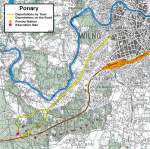 |
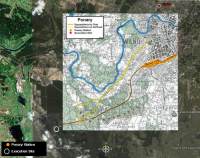 |
| GoogleEarth Image |
The first executions took place on 4 July 1941 (or even earlier). Groups of 100 - 1,000 Jews were brought from the city, made to undress, and then led, ten at a time, to the edge of the pit and shot. In the twelve days following 8 July 1941 as many as 5,000 Jews from Vilnius were murdered in this way. They had been led to believe that they were to be sent to labour camps. A Polish author, Józef Mackiewicz, was a witness to the massacres. He described these events in his book "Nie Trzeba Glosno Mowic" ("It Should Not Be Spoken Loudly").
By December 1941 the Germans had killed 3/4 of the Jewish population of Vilnius, at least 48,000 people.
Ponary was chosen for the mass-murder of Jews, Soviet POWs, and civilians because there were several large pits, dug there by the Soviets between 1940 and 1941, to serve as diesel or petrol supply storage resources for the Red Army.
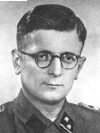 |
| Weiss * |
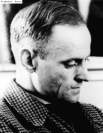 |
| Hering * |
The victims were herded together in one of the pits, ordered to undress, led to the neighbouring pit in groups of 10 - 20 people and shot. After the shooting in the pit was complete, the corpses were covered with sand, and the next group was summoned. Not all shots were fatal. Some Jews were just wounded. Thus some people were able to crawl out of the pit and return to Vilnius and its ghetto.
Herman Kruk (1897 - 1944 / a Jew from Warszawa who became stranded in the Vilnius Ghetto at the outbreak of the war, a librarian at the Strashuna Library. He kept a detailed diary, in triplicate, in which he made commentary on everything and everyone in the ghetto: Gens, the Jewish Police, the communists, the FPL - who was sleeping with whom, who was collaborating with the Germans... Its all in his diaries. He was deported to Estonia in July 1943, and ultimately perished the day before his camp was liberated by the Red Army. His diaries (which he hid in various locations) were scattered over the world, with many parties (ie the Soviets, the Lithuanians etc.) trying to destroy them) reported about escapees on 4 September 1941. Judith Troyak, a 14 year-old Jewish girl, told him about the mass-killings. Kruk wrote in his diary: "... it is my last wish: the words shall reach the world of living people - will the world not cry then? Will the world take revenge one day?"
A Polish journalist, Kazimierz Sakowicz, who lived at Ponary, noted in his diary:
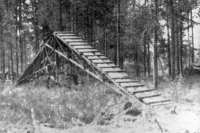 |
| Mobile Ladder * |
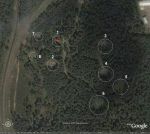 |
| GoogleEarth Image |
30 July 1941: About 150 persons shot. Most of them were elderly people. The executioners complained of being very tired of their 'work', of having aching shoulders from shooting. That is the reason for not finishing the wounded off, so that they are buried half alive.
2 August 1941: Shooting of big batches has started once again. Today about 4,000 people were driven up...shot by 80 executioners. All drunk. The fence was guarded by 100 soldiers and policemen. This time terrible tortures before shooting. Nobody buried the murdered. The people were driven straight into the pit, the corpses were trampled upon. Many wounded writhed with pain. Nobody finished them off."
Later in his diary, Sakowicz recorded:
"Bonfires burn near the station. They were kindled by policemen. Again a train from Vilna. They have arrived. The people were driven out from the carriages, and immediately a small batch was taken to the pit. The ones with poorer clothes on weren't even undressed. They were driven to the pit, and shooting began immediately. Another batch of people were standing nearby and, on seeing what happened to their nearest, began to yell. Some started running. A little lagging behind the others with her hair dishevelled, a woman is running, pressing her child to her breast. The woman is chased after by a policeman, he smashes her head in with the rifle butt, the woman collapses. The policeman seizes the child by its legs, drags it to the pit."
Aware of the advancing Red Army, the Germans tried to destroy the evidence of the mass killings. Paul Blobel, who had previously commanded Einsatzkommando 4a, responsible for the murder of 33,771 Jews over two days in September 1941 at Babi Yar (outside Kiev), amongst other atrocities, was ordered to perform this task. His Sonderkommando 1005 (code-name for this massive operation) arrived at Ponary at the end of September 1943. Between that time and April 1944, they exhumed and burned approximately 68,000 corpses at Ponary.
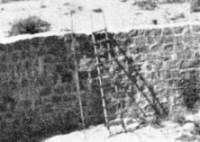 |
| Sonderkommando Pit * |
Yu. Farber, member of this Sonderkommando, described the horrible work:
"There was a technique for burning the corpses: on the edge of the pit was a small hearth, measuring 7 metres by 7 and built out of pine logs, a scaffold, one row of tree trunks stacked across other tree trunks, and in the middle was a chimney made from pine trunks. The first operation was to shovel the sand until a "Figur" (puppet) was uncovered; that is what the Germans ordered us to call the corpses.
The second operation was performed by the "hook-man", which is what they called the worker who extracted the bodies from the pit with an iron hook. The bodies lay close together. Two "hook-men", who were usually the strongest men from the work unit, would throw down a hook and pull out a corpse. In most cases the bodies came apart in pieces.
The third operation was done by carriers – the "Träger". They had to put a corpse on a stretcher, and the Germans made sure that they had a whole corpse on the stretcher, i.e. two legs, two arms, a head and torso.
The Germans kept a strict account of how many bodies had been removed. Our task was to burn 800 corpses a day; we worked from dawn until after dark. The "Träger" carried the bodies to the wooden hearth. There the figures were piled up in rows, one on top of the other. When one layer was stacked, spruce branches were put on top; a special worker, a "Haufenmeister", looked after the fuel and added dry logs to the fires.
When the logs and branches had been piled on, black fuel oil was poured all over them, then a second layer was piled on, then a third, etc. In this way, the pyramid would reach 4 metres in height, sometimes even higher. A pyramid was considered ready when it contained 3,500 corpses. It was thoroughly soaked with fuel oil not only from above, but also from the sides; the sides were covered with special dry logs, which were amply soaked with petrol, one or two thermite bombs were inserted, and the whole pyramid was set on fire…
A pyramid usually burned for 3 days. It had a characteristic short flame; thick, black, heavy smoke containing large flakes of black soot would rise up… A "Feuermeister" would stand nearby with a spade. He had to make sure that the fire did not die out.
After 3 days a heap of ashes would form, containing small bone fragments that had not burned through. The very old men and people who were physically feeble were used to tramp down the ashes. The burned bones were shoveled onto a huge iron sheet where they were crushed by the stampers so that not a single piece of bone would remain.
The next operation was to shovel the ground bones through a fine-mesh metal net. This operation had a double purpose. If nothing was left in the net, it meant that the bones had been well ground; and secondly, this process uncovered metal objects such as gold coins and other valuable items which had not burned.
One more operation should be mentioned. When a corpse was lifted out of the pit, a special worker inserted a metal hook in the corpse’s mouth, and if he discovered any gold crowns or bridges, he ripped them out and put them in a box…”
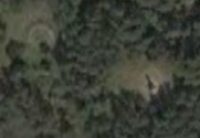 |
| GoogleEarth Photo |
1. A driver's statement (from: The Good Old Days: The Holocaust as seen by its Perpetrators and Bystanders, by Klee, Dreßen, and Rieß):
"I cannot say whether we arrived in Paneriai (Ponary) on 5 or 10 July 1941... While we were repairing our vehicles - I can no longer tell whether it was on the first or second day of our stay there - I suddenly saw a column of about four hundred men walking along the road into the pine wood. They were coming from the direction of Vilna. The column, which consisted exclusively of men aged between twenty-five and sixty, was led into the wood by a guard of Lithuanian civilians. The Lithuanians were armed with carbines. The people were fully dressed and carried only the barest essentials on them. As I remember, the guards wore armbands, the colour of which I can no longer recall. I do remember that Hamann and, I think, Hechinger went off after the column. About an hour later Hamann returned to our quarters. He was very pale and told me in an agitated manner what he had witnessed in the wood. His actual words were: 'You know the Jews you saw marching past before? Not one of them is still alive.' I said that this couldn't be the case, whereupon he explained to me that all the men had been shot. Any of them that weren't dead after the shooting had been given the coup de grace...
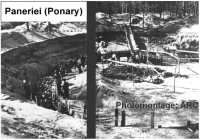 |
| Ponary Assembling Site #1 |
Together with some of my colleagues from my motorized column I followed this second group. As I recall, the NCOs Riedl, Dietrich, Schroff, Hamann, Locher, Ammann, Greule and possibly some others whom I can no longer remember came with us. After we had followed the group for about eight hundred to a thousand metres we came upon two fairly large sandpits. The path we had taken ran between them both. The pits were not joined but were separated by the path and a strip of land. We overtook the column just before we reached the pits and then stopped close to the entry to one of them (the one on the right). I myself stood about six to eight metres from the entry. To the left and right of the entry stood an armed civilian. The people were then led into the gravel pit in small groups to the right by the guards. Running round the edge of the pit there was a circular ditch which the Jews had to climb down into.
This ditch was about 1 - 5 metres deep and about the same again in width. Since the ground was almost pure sand the ditch was braced with planks. As the Jews were being led in groups into the pit an elderly man stopped in front of the entrance for a moment and said in good German, 'What do you want from me? I'm only a poor composer.' The two civilians standing at the entrance started pummelling him with blows so that he literally flew into the pit. After a short time the Jews had all been herded into the circular trench. My mates and I had moved up close to the entry to the pit from where we could see clearly that the people in the ditch were being beaten with clubs by the guards, who were standing at the side of the trench. After this ten men were slowly led out from the ditch. These men had already bared their upper torsos and covered their heads with their clothes...
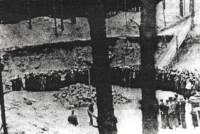 |
| Ponary Assembling Site #2 |
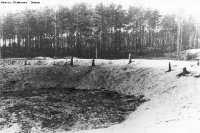 |
| Execution Pit * |
This gave me an opportunity to talk to one of them. I asked him whether he could really do such a thing just like that, and pointed out that the Jews had done nothing to him. To this he answered, 'Yes - after what we've gone through under the domination of Russian Jewish Commissars, after the Russians invaded Lithuania, we no longer find it difficult.'
During the course of our conversation he told me that he had been suspected of spying by the Russians. He had been arrested and had been thrown in and out of various GPU prisons, although he was in no way guilty. He told me he had only been a lorry-driver and had never harmed a soul. One of the methods they used to make him confess was to tear out his fingernails. He told me that each of the guards present had had to endure the most extreme suffering. He went on to tell me that a Jewish Commissar had broken into a flat, tied up a man and raped his wife before the man's very eyes. Afterwards the Commissar had literally butchered the wife to death, cut out her heart, fried it in a pan and had then proceeded to eat it. I was also told by comrades that in Vilna a German soldier had been shot dead from a church tower. For this another 300 - 400 Jews were executed in the same quarry. In this connection, I would also like to say that the very next day once again about the same number of Jews were led along the road into the wood. Apart from that one day I did not go to the execution area again...
I can only say that the mass shootings in Paneriai were horrific. At the time I said: 'May God grant us victory because if the Jews get their revenge, we're in for a hard time.'"
2. The co-driver's statement:
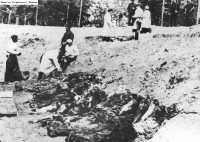 |
| Soviet Commission in 1944 * |
When we arrived at the spot, we saw people, who we subsequent learned from the leader of the squad were Lithuanians, in the act of carrying out mass shootings of Jews. On the path which ran between the two pits there was a light-machine-gun, pointing to the left, being used by the Lithuanians. In front of the machine-gun, standing by the edge of the pit, were ten delinquents, who were shot with the machine gun straight into the pit. I actually looked into the pit and saw that the bottom was already covered with bodies...
In the ditch that had been excavated on the other side of this execution area were the Jews who had not yet been shot. They were all men of different ages. I saw that they had to take off their shoes and shirts and throw them on to the side of the trench. The Lithuanians standing above were rummaging through these things. I also noticed that at one spot in front of the ditch there was a big mountain of shoes and clothes. While the Jews in the trench were getting undressed the Lithuanians beat them with heavy truncheons and rifle-butts. They were then led out of the trench ten at a time to stand in front of the machine-gun.
The leader of the Lithuanians spoke good German and we went up to him and asked what was going on, saying that this was a downright disgrace. He explained to us that he had once been a teacher at German school in Königsberg. For this the "Bolsheviks" had torn off his fingernails. Moreover, some of the members of the immediate family - parents, brothers and sisters - of this young Lithuanian who was doing the shooting had been captured at the station by the Bolsheviks before the arrival of the German troops and were to have been transported to Siberia. The transport did not take place because of the arrival of the German soldiers. As a result, all the people who were locked up in the wagons starved to death. Why they were now shooting these Jews, if indeed this Lithuanian's story corresponded with the truth, which I found highly improbable, and whether these particular Jews were the ones who had been involved in that action, he did not tell us...
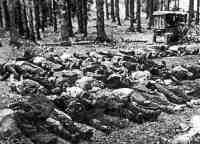 |
| Exhumations in 1944 * |
We kept going, however, and when we got close to him I said to him that there was no need to make such a fuss, as we had already seen everything. As we approached I saw that he was wearing a dark-coloured band on his left forearm with the letters "SD" embroidered on it. I now saw that slightly to one side there was a coach with two horses, a Landauer. On the box of the coach stood a second SD man whom I did not look at more closely. In the coach sat two very well-dressed elderly Jews. I had the impression that these were high-class or important people. I inferred this because they looked very well groomed and intelligent and "ordinary Jews" would certainly not have been transported in a coach. The two Jews had to climb out and I saw that both were shaking dreadfully. They apparently knew what was in store for them. The SS man who had initially gestured to us to keep away was carrying a submachine-gun. He made the two Jews go and stand at the edge of the pit and shot both of them in the back of the head, so that they fell in.
I can still remember that one of them was carrying a towel and a soapbox, which afterwards also lay in the trench...
I would also like to say that we all said to one another what on earth would happen if we lost the war and had to pay for all this."
3. A book-keeper's statement:
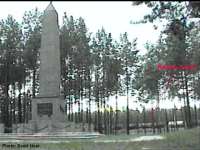 |
| Memorial 1 Site * |
Out of curiosity and to find out if there was a camp close by, Wahl, Corporal Dietrich and some other men from our unit - there must have been about five of us - set off about thirty or forty metres behind the column... After we had walked for about ten to fifteen minutes - I would say we had not gone more than 1 kilometre into the wood - we came to a clearing which looked like a building site. I later learned - I no longer remember from whom - that this building site was the work of the Russians, who had been planning to build a petrol warehouse on it.
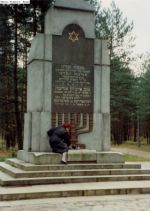 |
| Memorial 2 * |
The Jews then had to get into a line side by side with their backs to the machine-gun on the path. The guards stepped back a little or moved a little to one side and the order to fire was given in Lithuanian by one of the guards, whereupon the machine-gun started firing. The ten Jews keeled over and those of them not killed by the machine-gun fire were finished off with a bullet in the head by one of the guards.
Exactly the same procedure was followed as each group of ten Jews was led to the execution point and shot. We stayed there for about one hour and during this time some four to five groups were executed, so I myself watched the killing of about forty to fifty Jews."
At Ponary three killing pits are still to be seen today. Two memorials were dedicated after the war.
Trials:
Case Nr.192
Crime Category: Mass Extermination Crimes by Einsatzgruppen
Accused:
Hering, August life sentence
Weiss, Martin life sentence
Court:
LG Würzburg 500203
LG Würzburg 670921
Country where the crime was committed: Lithuania
Crime Location: Wilna (Vilnius/Vilna), Ponary
Crime Date: 4109-4407
Victims: Jews
Nationality: Lithuanian
Office: Einsatzgruppen EK3a, Polizei Sipo Wilna
Subject of the proceeding: Mishandling and individual killings of Jews from Wilna, as well as participation in mass shootings in Ponary of a total of at least 30,000 Jews from the Wilna Ghetto, the Lukischki Prison and from the surroundings of Wilna.
Published in Justiz und NS-Verbrechen Vol. VI
Photos:
GFH *
www.noarfamily.com/Vilnaghetto *
jbx France
Source:
Gilbert Martin. The Holocaust – The Jewish Tragedy, William Collins Sons & Co. Limited, London, 1986
Ehrenburg, Ilya & Grossman, Vasily, eds. The Black Book, Holocaust Library, New York, 1981
© ARC 2005